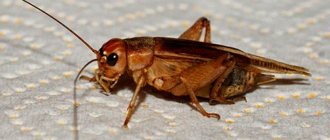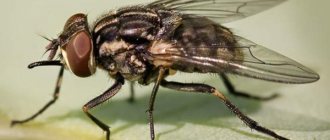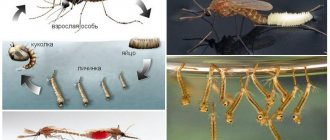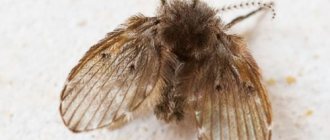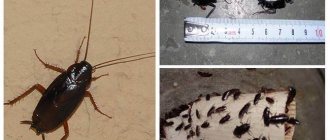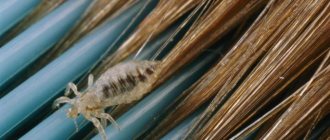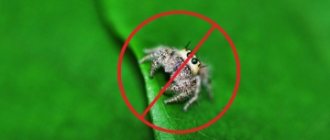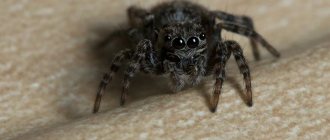What does a cricket look like? This insect of the family Gryllidae belongs to the grasshoppers. It has a cylindrical body, a round head and long antennae. The abdomen ends in a pair of long cerci; females have a long cylindrical ovipositor.
The hind legs have an extended femur, which provides strength for jumping. The front wings are hard and leathery, and some crickets chirp while rubbing them. The hind wings are membranous and folded when not used for flight. Many species do not fly. The largest are bull crickets, brachytrupes, up to 5 cm long.
More than 900 species have been described. Distributed throughout the world except at latitudes 55° and above, with greatest diversity found in the tropics.
Crickets are nocturnal, known for the loud, insistent song of males trying to attract females, although some species are mute. Singers have good hearing thanks to the eardrum on the shins of the front legs.
They are kept as pets from China to Europe, sometimes for fighting. They are eaten in Southeast Asia. Used to feed predatory animals in zoos. In Brazilian folklore, crickets are an omen of various events.
Description
Crickets belong to the order Orthoptera, which includes grasshoppers and locusts . These are small and medium-sized insects with cylindrical, vertically flattened bodies. The head is spherical with long thin antennae, behind them are two large compound eyes. There are three ocelli (simple eyes) on the forehead.
The first thoracic segment is trapezoidal in shape and strong. The insect is smooth and has neither dorsal nor lateral ridges.
At the tip of the abdomen there is a pair of long cerci (paired appendages of the posterior segment). In females, the ovipositor is cylindrical, long, narrow, smooth, and shiny. The hips of the rear pair of legs are significantly widened for jumping.
The tibiae are armed with several movable spurs, the arrangement of which is characteristic of each species. The tibiae of the front legs are used to receive sound.
The wings lie on the body and vary in size among different species. The front wings are made of durable chitin, acting as a protective shield for the soft parts of the body.
Males have stridulatory organs for producing sound. The hind pair is membranous and folds fan-shaped under the front wings. Many species have wings that are not adapted for flight.
The largest are the 5 cm long bull crickets (brachytrupes), which dig burrows a meter or more deep. Oecanthinae, arboreal insects are delicate white or pale green insects with transparent fore wings, field insects (Gryllinae) are strong, brown, black.
Description and characteristics
During the cold season, house crickets hide in buildings and heating mains. As summer approaches, they move outside. Unlike mosquitoes, flies and cockroaches, they do not cause negativity.
They love moisture. The Mediterranean climate is comfortable for them, where species diversity is greater than in other parts of the planet. Externally, the cricket looks like a beetle, but the thighs of its hind legs are thickened like those of jumping insects.
They see well, but lack dexterity, so they become easy prey for birds. The head is large. The body is elongated, ending in the cerci. Males and females have them. Thin long antennae give crickets a resemblance to black cockroaches, but the latter are not jumping.
Its habitat includes the countries of Europe, Asia, the Americas and Africa. The body length of an adult reaches 2.5 cm. The standard size is from 1.5 cm. The coloring of the brownie (domestic) species is uneven: on a brown background there are stains, spots and specks of light and dark shades.
Steppe crickets (field, garden) differ from house crickets in color, this can be seen in the photo. Their body is black, without inclusions. The length reaches 2 cm. At the beginning of summer, a new generation of insects appears, the larvae of which overwintered under covering material and remnants of vegetation.
Females are not particularly fertile. Each season lays up to 5 eggs. After the mission of procreation is completed, the female will die.
Habitat
They live in all parts of the world, with the exception of cold regions, latitudes above 55° north and south latitudes. The greatest diversity is found in tropical locations such as Malaysia, where 88 species can be heard chirping near Kuala Lumpur.
Members of several subfamilies live on the tops of trees, bushes, and among grasses. They are found on the ground, in caves, some are underground, digging shallow or deep holes. Others live in rotting wood, on the beach, and can run and jump on the surface of the water.
Chirping
Most crickets make a loud sound, stridulation. The stridulatory organ is located on the forewing, which has a leathery structure.
Find out more Scorpion stings: symptoms and treatment
The calling song attracts females and repels other males, and is quite loud. The aggressive song is triggered by contact chemoreceptors on the antennae, which detect the presence of a rival.
Crickets chirp at different rates depending on the species and the temperature of the environment. Most chirps faster at higher temperatures (62 chirps per minute at 13°C.
The relationship between temperature and chirp frequency is known as Dolbear's law. According to this law, counting the number of chirps made in 14 seconds and adding 40 gives the temperature in degrees Fahrenheit.
Ground crickets (Nemobiinae) are wingless, others have small fore wings and no hind wings (Copholandrevus). Gryllus assimilis are efficient and good fliers, others are clumsy fliers.
Reproduction and lifespan
There are usually several females per male. They were all enticed by the serenades. It is interesting to watch their mating dances, after which the female is ready to lay eggs. Depending on where the crickets live, the female lays a certain number of eggs. Mostly there are a very large number of them.
Crickets choose hard-to-reach cracks to store their future offspring. They usually contain 40,000-70,000 eggs. For their normal development, the temperature must be at least 28 degrees.
After 1-2 weeks, larvae begin to emerge from the eggs, which need to go through a maximum of 11 stages in order to become juveniles.
In this form, they already strongly resemble adult crickets, only they differ in their parameters. 6 weeks and several molts during the cricket breeding are necessary for insects to become sexually mature.
The lifespan of insects depends on their habitat. House crickets live for about 4 months. Tropical insects last 2 months longer. And field crickets can live up to 15 months.
What do crickets eat and do they bite people?
House crickets are omnivores. Deprived of natural nutrition, they consume a wide range of organic foods. Some are completely herbivorous, feeding on flowers, fruits, and leaves. Terrestrial species consume seedlings, herbs, pieces of leaves, and shoots of young plants.
Others are carnivorous, eating invertebrate eggs, larvae, pupae, scaly insects, and aphids. Many are scavengers, consuming organic remains, decaying plants, and fungi. In captivity, house crickets have been successfully raised on dry dog food with the addition of lettuce and aphids.
They have relatively strong jaws, and several species bite humans.
Nutrition
They are not picky when it comes to food. It is enough for them in the summer. All plant foods are used, from grass to plant roots. In winter, in secluded home dwellings, they also do not remain hungry.
Even if they go on a hunger strike, crickets do not disdain laying eggs of similar insects or dead relatives, which once again emphasizes their penchant for cannibalism.
Crickets, specially bred as an ornamental house insect, eat whatever is given to them - fruits, vegetables, food for other animals, bread crumbs, baby food and table scraps.
Insects need protein food, which is found in fishmeal and egg whites. Overeating insects is strictly contraindicated. This causes their chitin coating to deteriorate and causes problems with molting.
It is better to grate all vegetables and fruits. A prerequisite for crickets is the presence of water. It is not necessary to pour it into the drinking bowl, just moisten the sponge well with it.
Life cycle
Male crickets establish dominance over each other through aggression. They start by hitting each other with their antennae and inflating their mandibles. If they do not retreat at this stage, they resort to fighting, each making sounds completely different from those heard under other circumstances. When someone wins, he sings loudly, the loser is silent.
Females are attracted to males by song. After mating, the female eats the spermatophore (the male's reproductive organ).
Eggs are laid on the soil, in plant stems. To do this, females have a long, needle-shaped ovipositor. Terrestrial inhabitants do without this, either placing the eggs in an underground chamber or pushing them into the wall of the hole.
The short-tailed cricket (Anurogryllus) digs a chambered burrow, lays its eggs in a pile on the floor, and feeds its young for about a month after the eggs hatch.
These are hemimetabolous insects - the life cycle consists of an egg stage, a nymph, which resembles the adult form, the adult. The egg grows into a nymph about the size of a fruit fly.
The nymph goes through about 10 stages, becoming more like an adult with each successive molt. After the last molt, the genitalia and wings are fully developed, but a period of maturation is required before the insect is ready to reproduce.
Cricket Reproduction
Reproduction of crickets
Crickets are polygynous insects, that is, one male occupies a certain territory where several females live, forming a small harem. When attempting to attack strangers, they always sort things out by fighting, during which they bite off each other’s paws or mustaches and butt heads. Having won, the male often eats his opponent.
Interesting!
This spectacle attracts thrill-seekers, who in some countries even organize cricket competitions and fights. Moreover, a special diet has been invented for insects preparing for battle, and before the start, males are given dates with females to stimulate aggression.
The reproduction process can occur all year round, but their maximum sexual activity occurs in the summer. Mating usually takes place in a burrow, where the female comes, having heard the “trills” of the groom.
A few days after fertilization, the female lays eggs in a hole prepared in the ground, piercing the soil with her long ovipositor. The number of eggs depends on the temperature: the higher it is, the more. Usually it is in the range of 50-200 eggs; in the southern climate, the clutch consists of 500-600 eggs. They are shaped like small white bananas.
After 1-12 weeks, depending on the temperature, nymphs appear, which for the first days hide in a hole or under stones; there is no pupal stage. The larvae are usually wingless and smaller in size, otherwise similar to adults. During the growth process, the cricket larva molts 9-11 times, and only after 1.5 months. becomes a sexually mature individual. After each change of shell, the insect looks like a white cricket with unstretched wings.
On a note!
The largest cricket was discovered by a park ranger in New Zealand, who managed to feed it a carrot. The size of the insect was 18 cm in length.
Pets and for fighting
Crickets are kept as pets. An insect singing in the house is a sign of good luck and potential wealth. They are so treasured that they are often displayed in beautiful bamboo cages.
In China, Japan, and some European countries, especially on the Iberian Peninsula, they are kept in cages or hollowed out pumpkins, specially created forms. Insect fighting is a traditional Chinese pastime that dates back to the Tang Dynasty (618–907).
Find out more How to get rid of house flies in an apartment
The dominance and fighting ability of males depends not only on strength. They have been found to become more aggressive after isolation, or when defending a refuge. Forced to fly briefly, crickets fight two to three times longer than they otherwise would.
Are they eaten?
In southern Asia, including Cambodia, Laos, Thailand, Vietnam, insects are eaten as a snack made by deep-frying soaked and cleaned insects.
Cricket flour is used as an additive in consumer products such as pasta, bread, crackers, and cookies. Flour is used in protein bars, pet food, livestock, and industrial purposes.
They are bred as food for zoo carnivores, laboratory animals, and domestic animals.
They have a high protein and calcium content. Every 100 grams of insects you eat will provide 13 grams of protein and 76 milligrams of calcium.
veralline.com
Grasshopper or cricket?
The grasshopper and the cricket are insects that look similar to each other, but they are representatives of different families. Both of the same order are Orthoptera, and the families: grasshopper are grasshoppers, crickets are crickets. Grasshopper Grasshopper - there are a total of 6,800 species on all continents (except Antarctica).
One of the few insects that live openly in the grass. Not in cracks or holes. Grasshoppers escape from danger thanks to their ability to instantly disappear from a place with a sharp jump. For this reason, catching a grasshopper is not easy for a predator. Very often, grasshoppers have an appearance and color similar to the appearance and color of the leaves or other parts of the plants on which they live. It is noteworthy that grasshoppers are omnivores. They can feed on plant foods and other insects and larvae. That is, they are both herbivores and predators. Some species of grasshoppers prefer only plant food, some only predation. This makes grasshoppers similar to both praying mantises (fierce predators in the insect world) and locusts. Externally, grasshoppers bear little resemblance to praying mantises. But they are sometimes confused with fillies and locusts. Everyone has ever heard the chirping of crickets in forests and meadows. Sometimes this chirping can be quite beautiful. Cricket is a family of Crickets, or False Grasshoppers. Crickets have been known since the Triassic period and contain approximately 3,700 known living species in approximately 528 genera, as well as 43 extinct species and 27 extinct genera. Crickets live in crevices, under stones, in burrows, feed mainly on plants, but can eat other small invertebrates and soft tissues from corpses, including being capable of cannibalism. Two widely known species of crickets are Acheta domesticus (house cricket) and Gryllus campestris (field cricket). Crickets are bred for different purposes, some just like to watch them, like fish in an aquarium, some to feed other animals, and some for their singing and chirping. Field cricket is common in Central and Southern Europe, Asia Minor, North Africa and Western Asia. Prefers warm, sunny meadows and fields, light pine forests. It digs holes in the ground 10-20 cm deep and 2 cm in diameter. The house cricket originally lived in Eurasia, later it came to Australia and North America. The cricket is used by humans for bait when fishing, in Asia - as food, and is also widely kept and bred in various countries of the world as live food for domestic animals, for example, reptiles.
Differences between grasshopper and cricket:
- These insects are from different families.
- Grasshoppers have more developed hind legs, thanks to which they can make giant leaps.
- Crickets have more developed wings and fly, unlike grasshoppers, whose wings only help them when jumping.
- Crickets are usually smaller in size than grasshoppers.
- Crickets are predominantly dark in color. Grasshoppers have a variety of colors, mostly green.
- Crickets live in crevices and burrows, grasshoppers live openly in the grass.
- Crickets can easily live in human housing, and their behavior is similar to cockroaches. Grasshoppers prefer to live in the wild.
- Crickets chirp mainly at night. Grasshoppers “sing” during the day, in dry weather.
How to get rid of crickets
For some, the sound of crickets evokes images of sultry summer nights; for others, the incessant chirping only evokes rage. Do house crickets bother you? If so, try strategies to get rid of them.
Chirping in the yard: a familiar sign of summer. For some people, this sound has no charm; if you are unlucky enough to have a chirper living right under your bedroom window or sneaking into the house, the sound becomes a nightly nuisance.
Unfortunately, to get rid of crickets, you need to do more than just stand outside the door and yell, “Quiet!” Crickets do not listen to commands, no matter how desperate or heartfelt they may be. But there are other, more complex tactics that are being responded to. Read on to find out how to get rid of them.
Step 1: Find the source
The first and most difficult step is to find out where the crickets are hiding. It's best to follow the sound of chirping. Keep in mind that as you approach or near the nest, they will become quiet, hindering your efforts. Despite this, hearing helps narrow the search field.
When looking, focus on features that provide cover, as crickets like to nest in dark, damp environments. Look under the layers of mulch, the compost pile.
If you can find the nest, there are two options. One is to stop watering that part of the property, depriving the crickets of the water they need to survive. A slightly more radical method is to fill it with water. The goal is to force the singers to leave the nesting site.
For a lasting solution to the problem, we need to go even further. Because as soon as you resume regular watering, the crickets may return. To prevent this from happening, be sure to use expanding foam to fill any pockets you find.
Step2: Do it yourself or buy a pesticide
Crickets seeking shelter enter the house through foundation cracks and tiny holes around windows and doors. If it is too late to prevent access by sealing the building envelope, there are several ways to get rid of crickets that have found their way inside uninvited.
Don't discount the classic sticky traps and glue boards. If you're looking for an easy, inexpensive method, look no further than your kitchen pantry. A flask filled with a 1:10 mixture of molasses and water works great. Crickets attracted to the jar by the sweet smell will not be able to escape and will drown.
Alternatively, choose a store-bought pesticide spray. Follow the instructions carefully, and be aware that house crickets like to sit where it is dark and damp. Therefore, concentrate pesticide applications in the most likely areas, such as under the kitchen sink.
Find out more Why does a mosquito bite?
Step 3: Preventive Exterior Maintenance
Since you're dealing with an infestation, it's important to take steps to prevent it from happening again. No matter how well your home is sealed, it will never be completely bug-free, despite your best efforts.
Mowing the lawn, weeding the garden beds, clearing out yard debris—removing hiding spots—all discourage crickets. Also, try to create distance between the house and its landscaping by trimming bushes near the foundation. If you have a supply of firewood, try to store the logs away from the house. And don't forget to clean your gutters, they're a notorious haven for pests.
Finally, since light attracts crickets, consider limiting the use of outdoor lighting or switching to motion sensor lights.
Examples[edit]
Literature[edit]
- Aesop's fable about hardworking ants and a carefree grasshopper. Krylov, in his version of this fable, used the oza as an antagonist for the ant ,
but there is an opinion that this word in his time meant grasshoppers.
They strike
!
- It’s similar in the fairy tale about Buratino by A. N. Tolstoy.
- And the giant grasshopper Velka from the story “The Hole Moon”.
.
Cinema[edit]
- “Only “old men” go into battle” - Lieutenant Alexandrov received the nickname Grasshopper for catching these insects at the airfield.
- "The last Emperor". Many scenes involve crickets.
Cartoons[edit]
- Disney's Pinocchio - Jiminy Cricket.
- “The Journey of an Ant” (based on Bianchi’s fairy tale) is a grasshopper for whom the main character accidentally ruined a date with a female.
- “First violin” - like a young grasshopper, Udalets mastered playing the violin.
- “Little Raccoon” - in the song about a smile there is a line: “And the grasshopper sings on the violin.” Also in the episode you can see a grasshopper waving friendly to the main characters.
- "Battle Grasshopper" is the titular hero who protects the weak.
- "James and the Giant Peach" - a fiddler grasshopper, one of the main character's friends.
- “Contact” (1978) - here the grasshopper appears for a few seconds, but the final frames of the cartoon are dedicated to him, and through his image the idea of many worlds living inside every living creature is revealed.
- “Thumbelina” (USSR, 1964) - the grasshoppers are present at the ball, where Zhuk brings Thumbelina: two dance, and one plays the violin and announces that “the ladies are engaging their husbands!”
- Disney's Mulan is the Kri-Kri cricket that brings good luck.
- “The Adventures of Flick” aka “A Bug’s Life” - the leader of an intervening swarm of locusts leads a grasshopper on a leash, with which he frightens the oppressed ants. Which, given the real grasshopper diet, is very close to the truth. At the same time, the grasshopper is not only a kind of villain’s dog, but also an evil monkey - his antics and jumps are very characteristic.
- “Angry Beavers” - a cricket, accidentally intoxicated with the energy drink that the beaver brothers love, really scared Norbert and Dag.
Animated series[edit]
- "Maya the Bee" - Flip the grasshopper, Maya and Willie's friend. In one of the episodes, Flip's brother appears, who, having stolen his hat, greatly exposes the character in the eyes of other insects and others like them.
- By the way, this character appeared in a couple of episodes of the cartoon about Mole.
Comics[edit]
- DC Comics: The superhero Canterbury Cricket from Flashpoint is an anthropomorphic cricket superhero.
- In Marvel, in turn, several armored heroes appeared, nicknamed the Grasshopper... They became famous for the fact that almost immediately after their appearance they died the most ridiculous death.
Music[edit]
- Children's song "Little Grasshopper" to the words of Sergei Kozlov.
- Mikhail Shcherbakov, “Grasshopper Crickets.”
- The famous song with a tragic ending is “A grasshopper sat in the grass.” One of the first that children of the 1980-90s. They started teaching music at school, and she also appeared in the Soviet cartoon about Dunno.
- Song based on the poems of Anatoly Poperechny “Stoves and benches”: “Crickets sing tenderly on the stoves.”
- Children's song "Four inseparable cockroaches and a cricket."
Jerusalem crickets
Seeing a Jerusalem cricket for the first time is an unsettling experience even for those who are not prone to entomophobia. They look like giant, muscular ants with humanoid heads and dark beads. Although Jerusalem crickets (family Stenopelmatidae) are indeed quite large, they are harmless.
What they look like
In the 19th century, people used the expression "Jerusalem!" as a curse word, and this is believed to be the origin of the name.
People also believed (incorrectly) that these strange insects with human faces were highly poisonous and potentially deadly, so they were given nicknames rife with superstition and fear: beetles with bones on their necks, an old man with a bald head, the face of a child, the Child of the Earth (Niño de la Tierra). Among entomologists they are called sand or rock crickets.
Jerusalem crickets are 2–7.5 cm long and weigh up to 13 g. Most of these flightless insects are brown in color and have a striped belly with alternating stripes of black and light brown.
They are quite large, with strong bellies and large round heads. They do have strong jaws and can deliver a painful bite if handled incorrectly. Some species jump to avoid danger.
What do they eat
Jerusalem crickets feed on soil organic matter, both living and dead. Some collect garbage and hunt other arthropods.
They practice cannibalism on occasion, especially when they are together in captivity. Females often eat partners after the relationship ends (similar to mantis cannibalism , which is better known).
Special behavior
The insects wave their spiny hind legs in the air to ward off perceived threats. They are an important food source for bats, skunks, foxes, and coyotes.
If the predator manages to pull out the leg, the Jerusalem nymph will be able to regenerate the missing limb.
Types of crickets and their descriptions
Crickets belong to a species of insect that is a close relative of the well-known grasshopper and represents a group of long-whiskered orthoptera insects. Crickets get their name from the Greek word, which means “singer.”
Scientists divide crickets into several species. For example:
- Real crickets represent a whole family, which includes 3 species: house crickets, field crickets and Far Eastern stem crickets.
- Ant crickets (ant lovers).
House cricket
It is believed that the homeland of the house cricket is the Far East, as well as North Africa. Here they have been settling next to humans for a long time, both in their homes and in outbuildings. With the onset of warmth, crickets move to nature, and with the onset of cold weather they return to a person’s home or, as close as possible to its warmth. Crickets living in field conditions dig holes for themselves up to 30 cm deep. When they leave their burrows to feed or simply observe the territory, they cover the entrance to the burrow with grass.
The house cricket is distinguished by a gray-yellow hue, while the body is decorated with streaks of a brown shade, and on the head there are three stripes of the same shade. They grow up to 25 mm in length. There are eyes on both sides of the head, and rather long mustaches protrude from the front of the head, which serve as organs of touch. The insect's body is covered with a layer of chitin, which protects it from negative external factors and also prevents moisture loss.
This type of cricket has wings, which allows them to move quickly from place to place. When folded, they extend beyond the body size and resemble the tails of insects. In reality, house crickets cannot fly. Crickets have three pairs of limbs, each of which performs specific functions. The back pair is the strongest and due to them the crickets make jumps. The two anterior pairs perform the functions of auditory organs.
Only males produce unique, melodic sounds, which attracts females to continue their race. Sounds are produced due to the stradiculation vein, and sounds are produced due to the friction of this vein by the left wing.
Each type of sound has its own purpose. Some sounds are made in order to find a female, some sounds are made by the male in the process of courting a female, and some sounds are made in order to scare off potential suitors.
Interesting to know! Ancient beliefs say that the presence of a cricket in the house brings good luck to the residents and protects them from disease and evil, and that pregnant women will have an easy birth. It is believed that you should not get rid of crickets in the house, but not all residents like the fact that insects do not allow them to sleep. In such cases, they try to get rid of such vocalists.
If there are a lot of crickets in the area, then they can cause harm, causing damage to the vegetable harvest, including melons.
Field cricket
Field crickets are found in Southern and Central Europe, Asia Minor and Western Asia, North Africa, etc. Their usual habitats are areas with constant access to sunlight.
As a rule, field crickets live in meadows, fields, and also in pine forests. They live in the ground at a depth of 20 cm.
Compared to other species of their relatives, field crickets are more impressive in size, as they can reach a length of about 2.5 cm. The body of the insect is painted in a black, glossy shade, although there are individuals of brown color with orange spots. The head is round, and 2 antennae stick out on it - antennae. Simple eyes can be seen on the forehead.
Crickets are considered omnivorous insects, but they prefer to feed more on objects of plant origin. There are cases when they catch unwary insects or eat their corpses.
Stem crickets
Stem crickets are representatives of true crickets, which have the second name “eastern trumpeter”. They grow up to 1.3 cm in length, with a light green body and a black stripe at the bottom of the abdomen.
Due to the fact that insects lay eggs in the stems and petioles of plants, they received their first name. Each clutch contains 2-3 pieces. eggs At the height of summer, larvae hatch from the eggs. The larvae differ from adults in their smaller size, as well as in their wings, which are in a rudimentary state. Before the beginning of autumn, the larvae turn into adults.
The second name corresponds to its habitat, which is limited to the Far East, as well as China and Japan.
Ant lovers
Ant crickets are the smallest in size. As a rule, they grow to a maximum length of 5 mm, they do not have wings, and in appearance they resemble ordinary cockroaches. They are unable to make any sounds.
This species of cricket is native to South America, where it was discovered by a Swiss entomologist in the late 19th century. This species is also found in Europe. As a rule, they nest next to ants. Adults overwinter in an anthill, and the development cycle of larvae, starting from the egg-laying stage, is almost 2 years and consists of 5 stages.
THE MAIN MUSICIAN IS THE SINGING CRICKET!!!
Cricket farming is big business
Thanks to the demand created by owners and breeders of reptiles that eat crickets, breeding is a multi-million dollar business. Large breeders raise up to 50 million insects at a time in warehouses. The common house cricket, Acheta domesticus, is raised for trade as a pet.
Source
Jerusalem Crickets (Orthoptera, Stenopelmatidae), by David B. Weissman, Amy G. Vandergast, and Norihimo Ueshima. From Encyclopedia of Entomology, edited by John L. Capinera. “Crickets and Temperature,” University of Nebraska-Lincoln Department of Entomology. Cranshaw, Whitney and Redak, Richard. “Bugs Rule! An Introduction to the World of Insects.” Elliott, Lang and Hershberger, Wil. “The Songs of Insects.”
